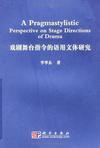戏剧舞台指令的语用文体研究
2007-11
科学
李华东
224
戏剧文体学是一门正在发展的学科,目前面临两个问题。第一个问题与研究方法有关:已有的文体分析框架往往混淆语用学与话语分析的区别,把两者都看作分析工具。第二个问题与研究对象有关:多数文体分析者对于舞台指令,要么视而不见,要么排斥在外,认为不值得研究(见第二章)。 本文尝试从三个方面解决上述两个问题。首先,本文通过理论思辨和例证表明,语用学和脱离语境的语言学(context-free linguistics,如音位学、形态学、句法学、语义学和话语分析)对于戏剧文体学的贡献是不同的,应该把前者看作阅读和分析戏剧文本的视角,而把后者(不考虑语境因素) 看作分析工具(见第三章)。其次,通过理论思辨和实验方法,本文表明,舞台指令是戏剧(尤其是现代戏剧)不可分割的一个部分,也应该是戏剧文体分析的重要对象之一(见第四章)。最后,本文尝试构建一套完整的戏剧语用文体理论,并在此基础上提出一套舞台指令分析程序。戏剧语用文体理论以语用学为研究视角,以语言学(尤其是话语分析)为技巧,以戏剧文本(既包含对白,又包含舞台指令)为研究对象,提倡戏剧话语形象化分析,把隐含意义推理作为中心任务,从而揭示体现戏剧文本关学价值的语言特点或风格。 舞台指令分析程序以舞台指令单位为核心,分为单位建立、单位分类、意义分析(既包含字面意义,或称符号,又包含推论)、确认美学性质、统计分析与讨论五个步骤(见第五章)。本文应用该程序,从易卜生的《玩偶之家》中选取三段样本进行实例分析。结果表明,对于舞台指令进行戏剧语用文体分析,可以揭示剧作家如何用舞台指令来刻画人物性格。该实例分析同时表明,本文提出的戏剧语用文体理论和舞台指令分析程序具有一定的描述力和解释力(见第六章)。
序AcknowledgementsAbstract内容提要Chapter 1 Introduction1.1 The rationale of the study1.2 Objectives of the study1.3 Methodology of the study1.4 Outline of the bookChapter 2 Stylistics of drama: The state of the art2.1 The pre-stylistic period2.1.1 The traditional literary critical approach2.1.2 The rhetorical-poetic approach2.2 The early stylistic period: The poetic-fictional approach2.3 The pragmatic and discourse analysis period: The study of the dialogue2.4 The pragmastylistic period: The study of stage directions2.5 A comparison and contrast of the different approaches2.6 SummaryChapter 3 Pragmatics as a perspective on dramatic texts3.1 The view of pragmatics as a tool kit3.2 The view of pragmatics as a perspective on language3.3 Different contributions of discourse analysis and pragmatics to stylistics of drama3.4 A pragmatic perspective on dramatic texts3.4.1 The phonological level3.4.2 The semantic level3.5 SummaryChapter 4 Stage direction as an important object for stylistic analysis4.1 Some theoretical preliminaries4.1.1 Which is the object of stylistics of drama, text or performance?4.1.2 The double-level structure of the dramatic discourse4.1.3 The production and comprehension of dramatic message4.1.4 Speech, act, and semiotics4.1.5 "Video discourse analysis" and "visualized discourse analysis"4.2 Stage directions as an important object for stylistic analysis4.2.1 Deletion and substitution: A way to elicit the importance of stage directions for stylistics of drama4.2.2 Stage directions in classical plays4.3 SummaryChapter 5 From page to stage: A pragmastyistic perspective on stage directions5.1 Pragmastylistics of drama: An integrated theory5.1.1 Defining pragmastylistics of drama5.1.2 Research questions drama pragmastylisticians attempt to answer5.1.3 The procedure for pragmastylistic analysis of dramatic texts5.2 A pragmastylistic perspective on stage directions of drama5,2.1 A pragmastylistic perspective on stage directions5.2.2 An analytical procedure of stage directions5.2.3 Analyzing and tagging the stage direction unit: An example5.3 SummaryChapter 6 Characterization revealed in stage directions6.1 Introduction6.1.1 Yu's stylistic study of the play6.1.2 My research questions6.2 Methodology6.2.1 Samples for analysis6.2.2 Process of analysis6.3 Results and discussion6.3.1 General statistics6.3.2 Characterization revealed by stage directions6.4 SummaryChapter 7 Conclusion7.1 Summary of the study7.2 Significance of the study7.3 Implications of the study7.4 Limitations of the study and suggestions for further explorationReferenceAppendix
《戏剧舞台指令的语用文体研究》由科学出版社出版。
